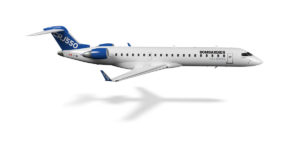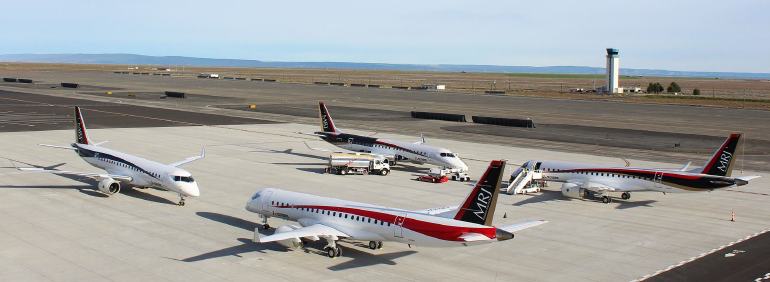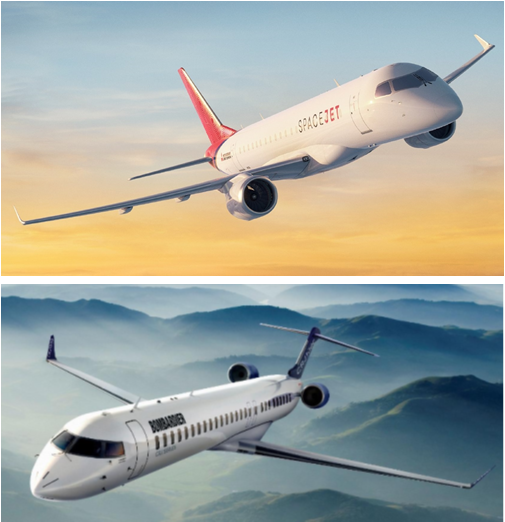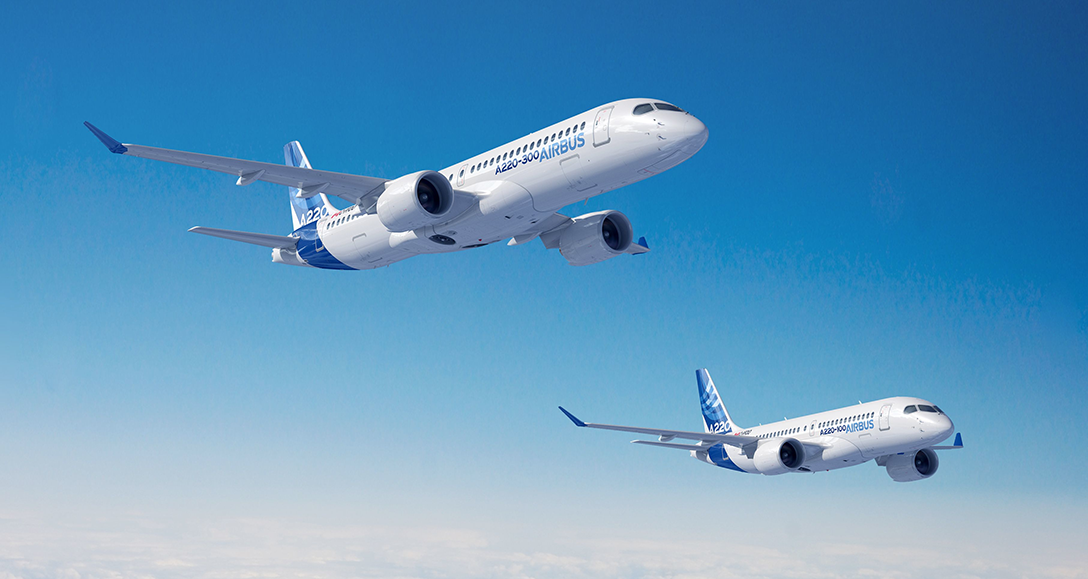Leeham News and Analysis
There's more to real news than a news release.
 Leeham News and Analysis
Leeham News and Analysis
- The Boeing 767 Cross Section, Part 1 November 24, 2022
- Movie Review: Devotion November 21, 2022
- China will accelerate development of its commercial aerospace sector November 21, 2022
- Bjorn’s Corner: Sustainable Air Transport. Part 46. eVTOL comparison with helicopter November 18, 2022
- The economics of a 787-9 and A330-900 at eight or nine abreast November 16, 2022
Airbus integrates the last pieces of the CSeries from Bombardier
September 3, 2020, © Leeham News: Airbus and its subsidiary Satair announced today it has integrated one of the last pieces of Bombardier’s engagement with the A220, the spare parts distribution.
Airbus acquired Bombardier’s part of the A220 aircraft program in January, but Bombardier continued to purchase, stock, sell and distribute the A220 spare parts. From the 1st of July, this is handled by Satair, part of the Airbus group, to give airlines with Airbus aircraft a single point of contact for spares part services.
Posted on September 3, 2020 by Bjorn Fehrm
European Regionals Face Hostile Operating Environment
Subscription Required
By Kathryn B. Creedy
Third in a Series. Previous articles:
- The future of regional jets is limited by choices, Scope Clause
- US Regional Consolidation Began Before Covid
Introduction
Aug. 31, 2020, (c) Leeham News: European regionals face far greater challenges than Covid and, sadly, much of what is happening to the industry is beyond its control. The result is similar to failures seen in the U.S. Flybe’s recent loss resulted from pre-Covid problems which also led to the pre-Covid failures of such airlines as Flybmi and Cobalt.
The failures illustrate, however, the three reasons why European regionals are so fragile – low-cost competition, geography, and challenging government policy.
Summary
- Government Policies Hardest on Regionals
- LCC Competition Challenging
- Consumer Protections Crushing
- Turboprops Have Large Role
Posted on August 31, 2020 by Kathryn Creedy
Airbus, Airlines, ATR, Boeing, Bombardier, Coronavirus, COVID-19, CSeries, E-Jet, Electric Aircraft, Embraer, European Regions Airline Association, European Regions Airlines Association, Mitsubishi, Pratt & Whitney Canada, Premium, Regional Airlines, SpaceJet
aircraft, airlines, aviation, flight, full-service carriers, low cost carriers, regional airlines
US Regional Consolidation Began Before Covid
Second in a Series on the Future of Regionals
Subscription Required
Introduction
By Kathryn B. Creedy
Aug. 6, 2020, (c) Leeham News: Many might assume the recent loss of three regionals – Compass, Trans States and ExpressJet – is Covid related.
 What is actually happening is the long-anticipated consolidation of the regional airline industry coupled with fleet restructuring and the most recent fallout of the pilot shortage crisis that began in 2013.
What is actually happening is the long-anticipated consolidation of the regional airline industry coupled with fleet restructuring and the most recent fallout of the pilot shortage crisis that began in 2013.
Reducing the number of regional partners also streamlines the inherent inefficiencies of the regional/major model.
Summary
- Regional airline industry is volatile.
- Mainline-regional model broken for many years.
- Rising costs eliminate some advantages.
Posted on August 6, 2020 by Scott Hamilton
Looking ahead for 2020 and 2030 decades: Embraer
Subscription Required
Fourth in a series.
By Bjorn Fehrm
Introduction
July 8, 2020, © Leeham News: All airliner OEMs have a disastrous 2020, but for Embraer, the year has been even worse. After spending a year and over $200m to carve out the Commercial Aviation division to merge it into Boeing, the Joint Venture Agreement (JV) was stopped by Boeing at the last moment.
The Executive Jets and Defense side were not affected, but now Embraer was organized as two companies instead of one. The company must now re-merge the organizations to save costs in a COVID-19 environment where limiting cash outflow, and lowering costs are necessary for survival. At the same time, it’s arch-rival on the world market, Airbus A220 has gone from strength to strength through basket selling with the popular A320.
How does Embraer come back from the Boeing pass up and regroup in a regional market that is no longer a fight of equals? Embraer competes with Airbus that in 2019 was 11 times larger in airliner deliveries and 29 times in airliner revenue.
Only in the below 100 seat market is it saved from the giant, who doesn’t have a model in the segment. And it seems the below 100 seat competitor, Mitsubishi, might fold its entry.
Summary
- The botched JV with Boeing came at the worst possible moment for Embraer, just when the COVID-19 pandemic stopped airliner deliveries.
- The planned JV had held back sales and deliveries, waiting for the JV to complete.
- In addition, it cost Embraer $200m, pushing it into the red for 2019.
- Embraer must now find another fix to the Airbus problem while wrestling with a worldwide COVID crisis.
Read more
Posted on July 8, 2020 by Bjorn Fehrm
The future of regional jets is limited by choices, Scope Clause
By Judson Rollins
Introduction
July 6, 2020, © Leeham News: The fallout from COVID-19 is beginning to intersect with the beginning of a wave of regional jet retirements globally. However, the market for smaller commercial jets today stretches the meaning of “regional” as most aircraft still in production have 100+ seats and can fly more than 2,500nm.
In the critical US market, both Embraer’s E175-E2 and Mitsubishi’s remaining M90 are too heavy to comply with the Scope Clause limits imposed by pilot labor agreements. These clauses restrict regional carrier flying to 76 seats and 86,000 lbs MTOW, while also capping the number of regional jets that can be flown by each carrier.
Delta Air Lines is limited to a total regional fleet of 450 aircraft, while American Airlines is capped at 75% of its single-aisle fleet and United Airlines is limited to 255 aircraft plus 90% of single-aisles in service. Earlier this year, American accelerated the retirement of some EMB-140s to maintain compliance with its limit.
Summary
- Regional jet utilization will be lower in the near term due to higher unit costs and US Scope Clause fleet limits.
- There will still be some replacement demand for regional jets over the next decade.
- Scope Clause relief is unlikely to happen in the coming round of US pilot contract negotiations.
- Lack of Scope relief will extend the life of Embraer’s E175-E1 through the 2020s.
Posted on July 6, 2020 by Judson Rollins
Regional Jet Retirements
Subscription Required
By Vincent Valery
Introduction
June 22, 2020, © Leeham News: Last week, LNA analyzed the narrowbody aircraft retirements. We now turn our attention to the regional jet market.
LNA analyzes retirement prospects for Embraer’s E-Jet and ERJ, the ex-Bombardier CRJ100/200 and CRJ700, Fokker 70/100, BAe 146/Avro RJ, Sukhoi Superjet 100, and Comac ARJ21.
Summary
- Four families dominate the market;
- Heavy geographical concentration;
- Challenges for old and small regional jets;
- Retirement trends in the two largest regions;
- Regional breakdown for the oldest types in service.
Posted on June 22, 2020 by Vincent Valery
Looking ahead for 2020 and 2030 decades: Airbus
First in a series of reports.
Subscription Required
By Scott Hamilton and Vincent Valery
June 17, 2020, © Leeham News: Airbus was riding high in February.
The A321XLR was a clear winner. An important order was won from United Airlines, up to then an exclusive Boeing narrowbody customer. American Airlines selected the XLR. An order was expected from Delta Air Lines.
Each order was another that made it impossible for Boeing to launch the New Midmarket Airplane (NMA).
In one of his first actions, Boeing CEO David Calhoun, taking office Jan. 13, put the NMA on indefinite hold, pending a complete review of Boeing’s product strategy.
The Boeing 737 MAX remained grounded by regulators, with no return to service in sight.

The Airbus A321XLR. This 9-hour capable airplane helps fragment routes–and soften demand for widebody aircraft. Source: Airbus.
Things couldn’t be going better for Airbus.
And then in mid-March, the COVID crisis became a global pandemic. Air transportation fell up to 95%. Airlines required government bailouts. Airbus CEO Guillaume Faury said the very existence of Airbus was threatened.
Summary
- COVID’s impact.
- A320 family ‘s commanding lead over Boeing.
- A220 commands low-end of single-aisle sector.
- A330neo is the weak link.
- Looking ahead in product strategy.
Posted on June 17, 2020 by Scott Hamilton
Mitsubishi’s options for the SpaceJet
Subscription Required
By Scott Hamilton
Introduction
June 2, 2020, © Leeham News: Mitsubishi Heavy Industry (MHI) yesterday closed the acquisition of the Bombardier CRJ program.
There are 15 CRJs in backlog to complete. But the purpose of the acquisition was to give MHI a global product support system for the SpaceJet.
With the aviation world still reeling and confused by the “suspension” of the SpaceJet program, what are the options going forward?
MHI last month announced it was suspending indefinitely development of the M100 SpaceJet. MHI said it will reevaluate the market demand of the M100. It suspended further flight testing of the M90 SpaceJet. It says it will proceed with office “validation” of the M90 for certification. Facilities in the US and Canada devoted to the SpaceJet program are closing. About half the workforce devoted to SpaceJet in Nagoya, Japan, is being reduced.
Customers that signed MOUs for 495 M100s and which have firm orders for some 200 MRJ90s (the previous brand for the M90) are in limbo. Suppliers are in limbo. MHI’s failure to communicate with them leaves a planeload of questions and no answers.
MHI’s move clears the way for Embraer to have a monopoly in the regional jet space. Unless—unless MHI restarts the SpaceJet program on its own or partners with another company to make a commitment to developing a new airliner.
LNA noted when the Boeing-Embraer joint venture collapsed that this presented opportunities for MHI and Boeing to renew and expand their previous relationship for the MRJ program. Here are some possibilities facing MHI.
Summary
- Kill SpaceJet entirely.
- Restart SpaceJet.
- Resuscitate the agreement for Boeing to support the MRJ program, updating it to the SpaceJet.
- Resuscitate and expand the previous agreement, strengthening the development SpaceJet and co-marketing by Boeing.
- Create an entirely new cooperative agreement, vastly broadening and strengthening decades-long ties between MHI and Boeing. LNA sees this as including SpaceJet and an entirely new family of aircraft replacing the 737 MAX.
- An expanded, broader agreement could even include development of a new “NMA Lite.”
- Finally, buy or create a JV with Embraer Commercial Aviation.
Posted on June 2, 2020 by Scott Hamilton
Mitsubishi SpaceJet retreat is the best news for Embraer in months
Subscription Required
By Scott Hamilton
Analysis
May 25, 2020, © Leeham News: Mitsubishi Heavy Industries (MHI) surprising retreat from its SpaceJet regional airliner program is the best news in months for beleaguered Embraer.
This takes pressure off the Brazilian manufacturer and gives it time to regroup after Boeing jilted it at the alter by walking away from a proposed joint venture.

Going into storage: four Mitsubishi MRJ90s at Moses Lake (WA). Photo: Mitsubishi.
MHI’s actions leave Embraer with a monopoly in the 76-100 seat arena vs new airplanes. The M90 SpaceJet is not a viable competitor to the E175-E1 or the struggling E175-E2. Embraer’s competition will be its own used jets, plus used Bombardier CRJ-700/900s.
Summary
- Closing US operations entirely. Closing the recently opened engineering center in Montreal
- Continued operation of the CRJ product support center in Montreal or relocation to Nagoya uncertain.
- Major cost-cutting drive.
- MHI wants to certify M90, then consider whether to proceed with M100.
- M100 has MOUs for 495 aircraft.
- MRJ90 was not certifiable due to design deficiencies.
- Redesigned M90 meets certification requirements.
- M90 is economically uncompetitive with E-Jet.
- COVID-19 upends entire airline industry, casting doubt in MHI’s commitment to SpaceJet future.
Posted on May 25, 2020 by Scott Hamilton
HOTR: Mitsubishi, Bombardier set June 1 to close CRJ deal
By the Leeham News staff
May 6, 2020, © Leeham News: Mitsubishi Heavy Industries announced May 7 (Tokyo time) that it will close the acquisition of the Bombardier CRJ program June 1.
Production of the CRJ was to end this summer. The COVID crisis effectively terminates the program now. But the CRJ itself wasn’t the reason MHI  bought the program, for US$500m. The attraction was the built-in global product support system for the CRJ that will transition to the M100 SpaceJet. It also provides a new revenue/profit stream as MHI enters the global RJ market.
bought the program, for US$500m. The attraction was the built-in global product support system for the CRJ that will transition to the M100 SpaceJet. It also provides a new revenue/profit stream as MHI enters the global RJ market.
Along with it, as icing on the cake, is acquisition of Bombardier’s sales team, infrastructure and other assets.
It would take years for MHI and Mitsubishi Aircraft Corp. (MITAC) to establish its own product support system.
 This is a major step in development of the SpaceJet as a new global competitor.
This is a major step in development of the SpaceJet as a new global competitor.
With the collapse of the Boeing-Embraer joint venture, MITAC can reinvigorate and strengthen its relationship with Boeing.
Embraer, which said it needed the Boeing JV to compete in the future with Airbus against the A220, increasingly faces higher risks as MITAC and MHI evolve the CRJ product support system and potentially strengthens the Boeing relationship.
MHI also announced that it will immediately write down the $500m acquisition by ¥50bn- ¥ 70bn ($470m-$656m).
Posted on May 6, 2020 by Scott Hamilton
Email Subscription
Twitter Updates
My TweetsAssociations
Aviation News-Commercial
Commentaries
Companies-Defense
Resources
YouTube
Archives
- November 2022
- October 2022
- September 2022
- August 2022
- July 2022
- June 2022
- May 2022
- April 2022
- March 2022
- February 2022
- January 2022
- December 2021
- November 2021
- October 2021
- September 2021
- August 2021
- July 2021
- June 2021
- May 2021
- April 2021
- March 2021
- February 2021
- January 2021
- December 2020
- November 2020
- October 2020
- September 2020
- August 2020
- July 2020
- June 2020
- May 2020
- April 2020
- March 2020
- February 2020
- January 2020
- December 2019
- November 2019
- October 2019
- September 2019
- August 2019
- July 2019
- June 2019
- May 2019
- April 2019
- March 2019
- February 2019
- January 2019
- December 2018
- November 2018
- October 2018
- September 2018
- August 2018
- July 2018
- June 2018
- May 2018
- April 2018
- March 2018
- February 2018
- January 2018
- December 2017
- November 2017
- October 2017
- September 2017
- August 2017
- July 2017
- June 2017
- May 2017
- April 2017
- March 2017
- February 2017
- January 2017
- December 2016
- November 2016
- October 2016
- September 2016
- August 2016
- July 2016
- June 2016
- May 2016
- April 2016
- March 2016
- February 2016
- January 2016
- December 2015
- November 2015
- October 2015
- September 2015
- August 2015
- July 2015
- June 2015
- May 2015
- April 2015
- March 2015
- February 2015
- January 2015
- December 2014
- November 2014
- October 2014
- September 2014
- August 2014
- July 2014
- June 2014
- May 2014
- April 2014
- March 2014
- February 2014
- January 2014
- December 2013
- November 2013
- October 2013
- September 2013
- August 2013
- July 2013
- June 2013
- May 2013
- April 2013
- March 2013
- February 2013
- January 2013
- December 2012
- November 2012
- October 2012
- September 2012
- August 2012
- July 2012
- June 2012
- May 2012
- April 2012
- March 2012
- February 2012
- January 2012
- December 2011
- November 2011
- October 2011
- September 2011
- August 2011
- July 2011
- June 2011
- May 2011
- April 2011
- March 2011
- February 2011
- January 2011
- December 2010
- November 2010
- October 2010
- September 2010
- August 2010
- July 2010
- June 2010
- May 2010
- April 2010
- March 2010
- February 2010
- January 2010
- December 2009
- November 2009
- October 2009
- September 2009
- August 2009
- July 2009
- June 2009
- May 2009
- April 2009
- March 2009
- February 2009
- January 2009
- December 2008
- November 2008
- October 2008
- September 2008
- August 2008
- July 2008
- June 2008
- May 2008
- April 2008
- March 2008
- February 2008



